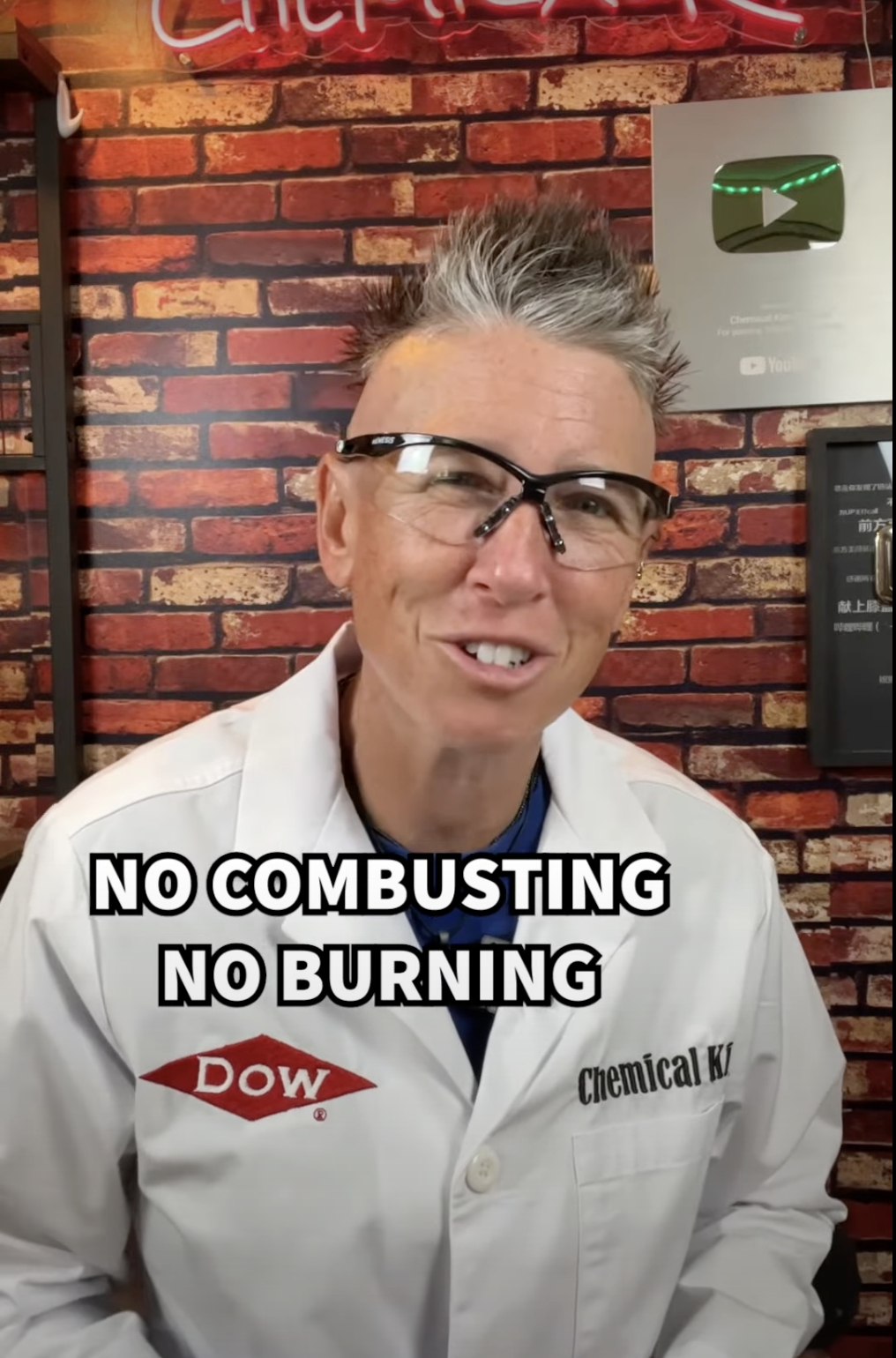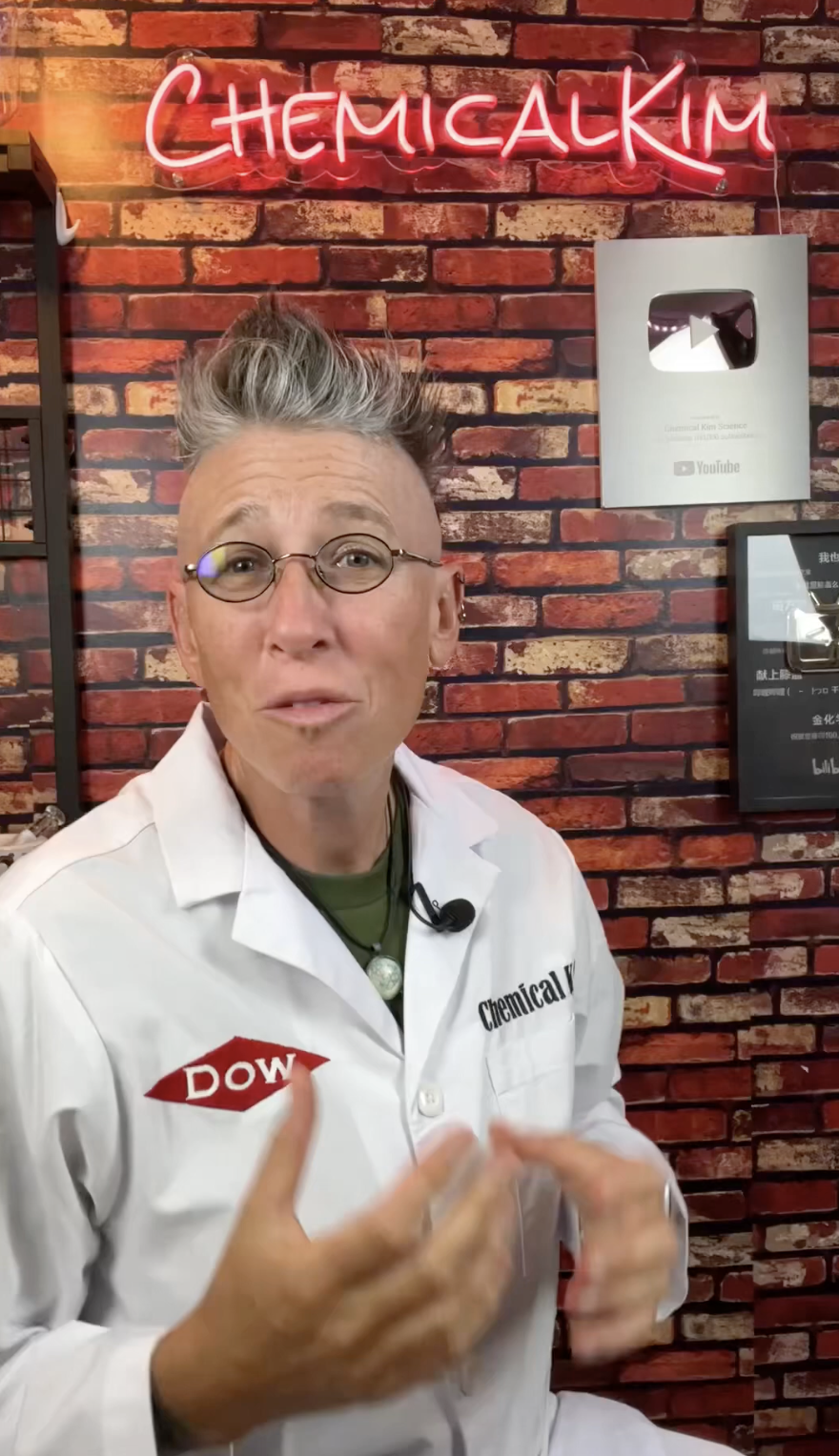A TikTok Tale: Chemical Kim and Dow
As the world races to develop and scale solutions for myriad global sustainability challenges, a diversity of perspectives will be key. That’s one reason why, in 2015, the United Nations dubbed February 11 the “International Day of Women and Girls in Science.” Women make up less than 30% of the world’s researchers today. STEM fields must do more to welcome and encourage women-identifying students and workers — because lived experiences often yield the most targeted solutions.
Kim Hilton is one key voice working to close the gap. When she turns on her camera, she brings the magic of science to viewers around the world — including women and girls who are interested in pursuing careers in science. Known as Chemical Kim on her social media channels, the chemistry professor and influencer has more than 1.4 million TikTok followers and a talent for unpacking complex topics with hands-on education — like in this TikTok video on advanced recycling.
Jill Martin, Dow’s Global Sustainability Fellow, shares Kim’s passion for the advancement of women-identifying students and employees and appreciates her work to expand sustainability education in accessible ways.
“Circularity and sustainable plastics can be a complex space. Kim’s content shows how new technologies and innovators are addressing plastic waste and creating more sustainable and circular products,” Jill explained.
In celebration of this year’s 8th annual International Day of Women and Girls in Science, Jill recently spoke with Chemical Kim about her passion for supporting women-identifying, science-interested people in STEM.
Jill: How did you go from chemist to TikTok influencer?
Kim: My passion is making science education inclusive and accessible for everyone. For more than 25 years, I’ve shared science demonstrations and activities with kids at local schools, community groups, libraries, museums and even a local children’s hospital.
Fifteen years ago, I developed the “Chemical Kim Science Show” on local public access television, which led to a biweekly segment on a morning show. I turned to TikTok during the pandemic to keep bringing science lessons to kids and encouraging discovery and investigation in their own environments.
Jill: What advice do you have for your TikTok audience, especially those who identify as women or girls?
Kim: It’s important to find a role model. Women are a minority in science, and many scientists you learn about in school or online won’t be women. Reach out to other women in science that you admire and feel a connection to. Having women in science is a necessity as diverse minds and diverse thinking are important in the advancement of research and development.
For my TikTok audience at large considering careers in science, look to your curiosities. Most people in STEM, including myself, sought science as a career because we’ve been curious from a young age. It’s important to recognize that studying science won’t provide answers to your curious questions — but it will provide you with the tools to seek the answers.
The other very important piece of advice is to embrace this passion to learn science. The courses are challenging and require a lot of time and hard work, but the commitment will be worth gaining the knowledge and understanding of the world around you along with having a career you will enjoy and that you worked so hard to achieve.
Jill: What has your personal experience been like as a female influencer in the STEM space? Any examples?
Kim: I’ve had parents, kids and young adults tell me how much I am a role model. One of my favorite exchanges involved a mom and her 10-year-old daughter approaching me at a large amusement park. The daughter was extremely excited to meet me and shared that she watches all my videos and loves performing my science activities.
A few weeks later, I received an email from this same mom, sharing a picture of her daughter dressed up as Marie Curie for Halloween. The mom explained that after discovering Chemical Kim, her daughter has become obsessed with learning science.
I also receive comments and messages from young women in high school or college sharing that they are going into science because I’ve shown how fun learning science can be.
Jill: How do you see sustainability playing a role in STEM and in engaging women and girls in science?
Kim: I predict today’s role of sustainability in STEM and engaging women and girls in science will be like the role environmental studies has had since the early 1990s, when I was an undergraduate attending Michigan Technological University, a science and engineering-focused college.
At that time, degrees in environmental science or environmental engineering were scarce and mostly a focus of study in biochemistry or civil engineering degrees. But over the past 30 years, some of the greatest increases in undergraduate and graduate STEM degrees have been in environmental science and engineering.
The impact at Michigan Tech alone brought the construction of the Dow Environmental Science and Engineering Building. And although engineering is a historically male-dominated space, environmental engineering is seeing this gender imbalance flipped at some colleges across the country with women equal to or greater than men in enrollment. Now, sustainability is at the forefront of environmental science and engineering degrees, research and careers. I am excited about the future progress of environmental science with diverse voices and ideas involved, particularly those from women and minority groups who have been previously left out of the conversation.
Jill: Why and when did you start talking about plastics on your TikTok channel?
Kim: My first viral plastic video, posted in 2021, featured a simple how-to on making samples of starch-based plastics — and it got more than 2 million views! The idea for this video came from my followers’ interest in bio-based plastics made from renewable biomass sources, like vegetable fats and oils, corn starch, straw, woodchips, sawdust and recycled food waste. Since many of my viewers don’t have a strong background in science, I jumped at the opportunity to connect chemistry to their everyday lives through that first video.
Jill: Who has been most responsive to your videos about plastic?
Kim: I was pleasantly surprised to discover that my videos about plastic are popular outside of the U.S., especially in places like the Philippines and Indonesia. In both countries, viewers have shared comments about how they reduce plastic waste in their everyday lives. In contrast, people post comments that are skeptical about recycling and sustainable plastics, which creates an opportunity for healthy dialogue. My goal is to highlight how science is key to tackling issues like climate change and the immense potential it has to make an impact.
"During our partnership, I’ve been both surprised and excited to learn about Dow’s investment in both advanced and mechanical recycling and its efforts toward creating a zero-waste economy."
Jill: What did you know about Dow before our partnership? What were you surprised to learn during the partnership about our company?
Kim: I completed my chemistry undergraduate and graduate work in Michigan schools and lived near Dow’s headquarters for several years, so I have always been interested in its work. During our partnership, I’ve been both surprised and excited to learn about Dow’s investment in both advanced and mechanical recycling and its efforts toward creating a zero-waste economy. I feel great pride in this partnership and the ability to share on my platform that one of the largest plastic manufacturing companies in the world is taking a bold step toward fixing our plastic waste problem.
Jill: How do you hope your content will contribute to conversations around plastics?
Kim: I’m hopeful that my followers and others will feel more motivated to reduce, reuse and recycle plastics after understanding the science behind how they are made and repurposed. I strive to help consumers look at plastic waste as a resource. Thanks to Dow and advanced recycling, we are teaching people that plastic’s value goes far beyond its first use.



